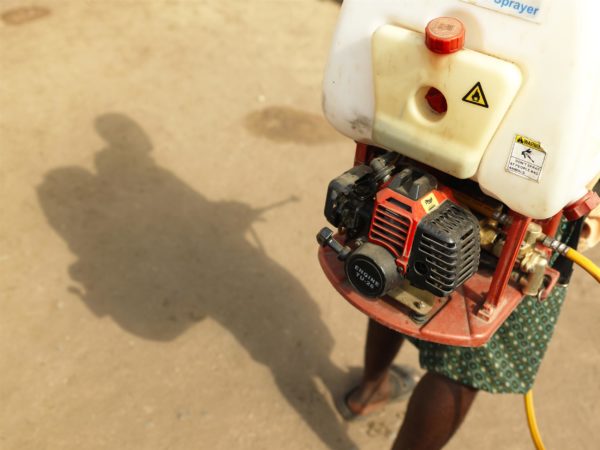The world’s five biggest pesticide manufacturers are making more than a third of their income from leading products selling chemicals that pose serious hazards to human health and the environment, a joint investigation by Unearthed and Public Eye has found.
Analysis of a huge database of 2018’s top-selling “crop protection products” has revealed the world’s leading agrochemical companies made more than 35% of their sales from pesticides classed as “highly hazardous” to people, animals or ecosystems.
The investigation identified billions of dollars of income for agrochemical giants BASF, Bayer, Corteva, FMC and Syngenta from chemicals found by regulatory authorities to pose health hazards like cancer or reproductive failure.
It also found more than a billion dollars of their sales came from chemicals – some now banned in European markets – that are highly toxic to bees. Over two thirds of these sales were made in low- and middle-income countries like Brazil and India.
By far the most valuable markets for the highly hazardous pesticides sold by these companies were the commodity crops soya and corn, grown in large part to provide animal feed for the meat industry.
Visualisations by Nadieh Bremer
Industry database
The database, obtained from leading agribusiness intelligence firm Phillips McDougall, covers $23.3bn in pesticide sales across 43 different countries. These sales represent the leading products in the world’s highest-spending pesticide markets, and amount to around 40% of the global agrochemical market.
Unearthed and Public Eye, an NGO that investigates human rights abuses by Swiss companies, combed this dataset for sales of chemicals on the Pesticide Action Network (PAN) International list of highly hazardous pesticides (HHPs).
The investigation found that close to half (41%) of the leading products of the agrochemical giants BASF, Bayer, Corteva, FMC and Syngenta contained at least one HHP.
There is a huge disconnect between what those companies are saying and what they are actually doing
Between them these companies control close to two thirds of the global agrochemicals market, and comprise five out of six members of the influential lobby group CropLife International.
Of the $13.4bn of sales by the CropLife companies in the dataset, $4.8bn went on chemicals found by regulatory agencies to pose hazards like acute poisoning or chronic illness in people, or high toxicity to bees and other wildlife.
The group’s full annual income from these chemicals will be billions of dollars greater, because the data analysed covered less than half of total global sales.
The investigation’s key findings include that:
- The CropLife members made 10% of their leading products income ($1.3bn) from chemicals classed by the US Environmental Protection Agency (EPA) as highly toxic to bees. These include neonicotinoids produced by Germany’s Bayer and Switzerland-based Syngenta, which were permanently banned from outdoor use in the European Union in 2018. Brazil was their main market for these chemicals.
- CropLife members made almost $3bn (22% of sales) from chemicals found by regulators to pose chronic health hazards. Among their top sellers were BASF’s weedkiller glufosinate and Corteva’s fungicide cyproconazole, both classed by EU regulators as damaging to fertility, sexual function or the unborn child. But by far CropLife’s biggest seller was glyphosate, classed by the International Agency for Research on Cancer as a “probable human carcinogen”. Glyphosate manufacturer Bayer and various regulators have rejected this classification.
- CropLife members made $596m (4%) of sales from pesticides classed as highly toxic by the World Health Organisation (WHO) or as fatal if inhaled. Syngenta accounted for a large majority of these sales, with its top sellers including paraquat, a herbicide so toxic that a single sip can kill, which has long been banned in Europe and Switzerland.
- The CropLife group made the majority of its highly hazardous pesticide sales in low- and middle-income countries like Brazil and India, where experts say the risks posed by using these chemicals are greatest.
- These companies’ biggest markets for highly hazardous pesticides were the commodity crops soya and corn. These two crops alone accounted for around half of CropLife HHP sales.
- These five companies alone accounted for almost half (48%) of all HHPs identified in the Phillips McDougall database.
Meriel Watts, a senior science and policy advisor to PAN, told Unearthed: “This investigation shows that there is a huge disconnect between what those companies are saying in the international policy arena and what they are actually doing.”
What is CropLife International?
CropLife International is an influential trade association and lobby group for the world’s major agrochemical and agricultural biotech companies. Its members Syngenta, Bayer Crop Science, BASF, Corteva Agriscience, and FMC are the five biggest pesticide companies in the world by agrochemical turnover. CropLife’s sixth member is the Japanese company Sumitomo Chemical, the world’s 8th biggest pesticide company. Sumitomo is not included in this investigation.
In international negotiations on pesticide regulation, the CropLife International lobby group is a well-funded and influential voice. Its members include the five leading agrochemical companies by turnover, plus the Japanese company Sumitomo.
CropLife argues that HHPs are an “important tool to fight against crop losses” and should be used as a last resort to help farmers “produce enough food for a growing population”.
But the group says the majority of HHPs sold in developing countries are not manufactured by its members, and that its own members have “led by example” with measures like training millions of people in risk reduction techniques, such as wearing protective equipment.

However, Baskut Tuncak, the United Nations’ special rapporteur on toxic substances and human rights, rejected the idea that the risks posed by HHPs could be managed safely.
